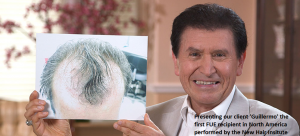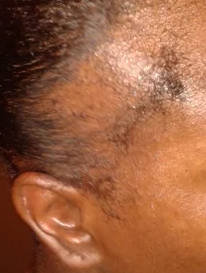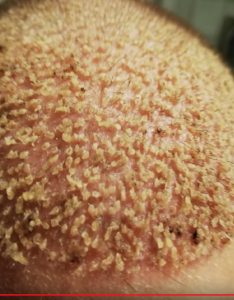We use a standard double accounting system when we perform an FUE. We count the number of attempts at FUE, then we count the number of grafts that come out. By subtracting the difference, this tells us how good we are at the process. Then, we recount them when they are examined, trimmed and placed into the recipient area. All of this activity is recorded on the patient’s surgical report which is available to any of our patients who want to see it.
Background: I’m 34, 35 in May. I noticed that I was losing hair when I was 27. Crown first, then hairline. The hairline isn’t noticeable unless taken at an overhead angle as attached. I lose hair in a pattern, but it’s also thinning. I have the same hairline as when I was in my early 20’s, but it’s thinned out. My hairline has not moved upwards, meaning I don’t have a V shape. The crown is obviously thinning but it is only extremely noticeable in bright pictures. In some pictures, I just look as if I have a blonde spot in the midst of my dark brown hair.
The consensus is “wait, you may lose more hair,” but it has been the same if not a bit better (cause treatment) for probably 5 years. So I’m starting to think: if I do lose more, it will be a long time from now, or very slowly and I can react to it— so why not go for the HT now?
I dermaroll 1.5 weekly, minoxidil daily, 2% niz. I have tried finasteride 3 separate times, splitting pills in half, taking them every other day. I experienced side effects every time -brain fogg and low libido. Finasteride’s side effect profile for a cosmetic drug is not a good trade off in my opinion. I won’t be trying it again no matter the consequences.
I was going to post this on RealSelf, but the doctors seem to tend to reply with a lame copy and pasted response.
Thoughts on HT in my position?
You are correct to stay away from finasteride. One good option is that you get Scalp Micropigmentation which will create a thickened, much fuller look. You must be prepared, however, that over time the thinning MAY lead to balding, so a plan must be created to address your next step. I am big on a Master Plan for anything you do (see:https://scalpmicropigmentation.com/thinning-hair-gallery/)
I’m just also wondering why, when so many men took 5 times the dosage for BPH prior to it ever even being used for hair loss, that we didn’t hear about all of this sexually related morbidity- especially when you consider who was doing most of that initial prescribing: Urologists. I mean, these would have also been the first line guys to field those complaints.
Seems the one side effect they did hear about was the hair growth- which led to the realization DHT was involved in hair loss. And exactly – in addition- where are the actual studies?
“His point needs to be addressed. These original patients were mostly over 55 years of age, but at 5 times the dose one would expect more post finasteride syndrome, yet it was never reported other than the limited numbers when subtracted from the placebo effect as sexual side effects were reported in the original study of finasteride at about 2% and I am certain that men over 55, may have a lower sex drive to account for a lack of reporting I take finasteride at the 1mg dose and don’t have sexual side effects”. Dr. Tim Carmen
“I’m not convinced that side effects are dose dependent, at least comparing 1mg to 5 mg. Most of the discussions about reduced side effects using 0.5mg are anecdotal. I believe that the subgroup of men with side effects are somehow more sensitive, which may be unrelated to dosage. They also seem to be an age group under 35yrs. Also, Merck researchers knew that finasteride could potentially grow hair, but needed to get FDA approval first for BPH”. Dr. Ed Epstein
This is an interesting new approach to hair loss. We need to wait to see the FDA safety and effectiveness studies on this compound.
Mystery compound found to be safe and effective at treating hair loss. Details in comments. from tressless
I had an anxiety attack on Thanksgiving day and got terrified and got off finasteride that day. Ever since then, my anxiety has been through the roof. I can hardly sleep. Before that day of the attack I was fine. I mean I always kind of had anxiety and depression but this is on another level. This can’t be from the finasteride correct? Also can you experience withdrawals from finasteride?
This is a classic anxiety attack that has nothing to do with the actual drug.
I’m trying to determine if I lost any grafts after a recent FUE. I was extremely gentle and did not touch the grafts until day 5 when I was instructed to use moderate pressure and rub at the crusts to remove them. Some of the spots, especially near the hairline and temples were still acutely tender. I expected hairs to still be attached to the crusts. Many hairs did fall out with them. I have read your study on how long it takes grafts to anchor. My question is how much bleeding is typically associated with a graft loss? Just a spot? An ooze? A trickle?
Many places say you probably didn’t lose any grafts unless there was pain or bleeding. But they never specify how much bleeding. I am now at day 7. And hairs began falling off at day 5 with the pressure, which worries me that it was too early. Also, can I use lotion or moisturizer on the recipient site? It tends to dry out.
I wrote that paper with Dr. Bernstein on Graft Anchoring (see here: https://baldingblog.com/wp-content/uploads/pdf/mp-2006-graft-anchoring.pdf). As long as there are crusts attached to the grafts, you must not pull them off. This is why I get all of the crusts off on day one. You can use a conditioner after shampoo and moisturize after the crusts are off.
I have examined many of my patients over decades who have had miniaturized hair, went on finasteride, and then reversed the miniaturization.
Guillermo started his FUE in 1998 and followed his hair loss with us since then. As he got older, he lost the central forelock which shows prominently in the before photos that he is holding. As you can see, his FUE is nothing short of normal looking. We published the first article in the world on FUE in 2002 based upon 6 years of clinical research and the rest is history. Every hair surgeon in the world, having read the article, started performing FUE. It took years for most hair surgeons to perfect the technology.
See original article here: https://newhair.com/wp-content/uploads/2018/11/mp-2002-fue.pdf
You have classic traction alopecia which resulted from the braids you had when you were a child. These pulled out your hair and only a hair transplant can fix this problem. A secondary diagnosis could be triangular alopecia, an inherited hair loss pattern in the location where you have lost your hair. A hair transplant is also the only solution for this.
These are the remnants of the scabs (crusts) that you did not wash off. They are now filling up with water and are elevated. They should easily wash off with a good shampoo and gentle rubbing with your fingertips. I never see this problem in our patients because we wash off the crusts the day of and the day after the surgery so that they never form.
Yes, some people can recede without balding. This means that their frontal hairline may work its way back to blatant frontal balding without loss of hair elsewhere. However, sooner or later, many men will develop balding elsewhere on their scalp. If it bothers you a great deal, then a hair transplant (an FUE) can solve the problem.
He violated this patient’s rights by using this ad to promote his hair transplant services. This is a misrepresentation by the doctor defining a standard of care that is our standard of care, NOT HIS standard of care. In the State of California, a doctor can (by law) lose his license to practice medicine with such fraudulent representations. I omitted the doctor’s name at the bottom of the ad as I will deal with him through my attorney.
Hair loss in women like you, if you don’t have a curable situation, can be very effectively treated with Scalp Micropigmentation, which makes the hair look great (see here: https://scalpmicropigmentation.com/smp-for-women/).
Balding at 25!? Minoxidil/Alopecia & Acne Diary from tressless
I have read that body tattoos when performed in volume, placed deep in the dermis, can migrate and develop embolisms to the brain and other organs, in this case, the eye. I have discussed some of this in my article: https://newhair.com/
We use only organic pigments that are placed at the very upper part of the dermis as shown in my recent post on baldingblog: https://newhair.
https://jamanetwork.com/journals/jama/fullarticle/2723634
I am a 20 year old male who is worried about some hair loss at the neckline/nape of the neck region. I currently do not have any signs of balding in the crown or the hairline. But for some reason, every time I pull on the sides of the neck hairline, one or two tapered hairs fall out. My question is whether or not androgenic alopecia can affect this region or if it is determined by other genetic factors?
In some individuals, the neck hair is genetically programmed to fall out early. Rarely have I seen this in a 20 year old, but it is not uncommon in a man over 35. A few hairs may not mean that you are losing neck hair but just normally cycling hairs.




